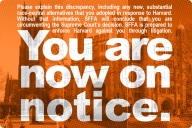You have /5 articles left.
Sign up for a free account or log in.
We’ve all sat through -- and given -- presentations with too many PowerPoint slides. Moreover, we’ve all toyed with the various ways of trying to make complex theories, long quotable quotes from scholars or field observations, or enormous statistical tables into a single overhead screen. Many of us have also seen the guidelines and op-eds about what a good PowerPoint slide looks like, but few academics have a budget for a designer to really help with graphic elements. Moreover, the presentation of original research (or even proposals for original research) is different from the style and content of presenting with PowerPoint in the corporate world.
So what is a good starting point for a basic first draft of a presentation for any circumstance in which you are presenting your own research? What would work across audiences, whether you are presenting to a group of students in a classroom, peer researchers at a conference, prospective colleagues at a job talk, or the public?
A good way to start is by imagining a dozen slides. Obviously, the content that goes into this outline will vary, depending on whether you are doing quantitative, comparative, qualitative or humanistic inquiry. But this outline should be flexible enough to serve you in a short conference presentation or a long job talk: the basic goals and ingredients are the same. Indeed you may find that this outline exposes some of the shared assumption about what research can be across the humanities or the natural, physical and social sciences. Like an essay, there are some standard ingredients that research presentations should have. Some disciplines have their own conventions and your mentors should coach you on what these are. But not having the basic ingredients risks communicating that you have not been fully professionalized as a researcher.
Less Is More
There is an old adage that good data visualizations have a low ink-to-data ratio. You want every drop of ink to communicate something meaningful, and bedazzling colors or animations detract from what you want to communicate. Similarly, after you chose a background color for your presentation, only add pixels of text and color to communicate information. If the pixel is communicating something that you will be saying out loud during the presentation, it may not be needed. If playing with pixels is more about design than data, you are simply decorating your ideas and evidence. And Orwell’s writing rules can be adapted for conference presentations and job talks:
- Never use a metaphor, simile or other figure of speech that you are used to seeing in print or saying colloquially.
- Never use a long word where a short one will do.
- If it is possible to cut a word out, always cut it out.
- Never use the passive where you can use the active.
- Never use a foreign phrase, a scientific word or a jargon word if you can think of an everyday English equivalent.
- Break any of these rules before presenting anything outright barbarous.
Practically speaking, this means it is OK for you to edit quotes and use ellipses or hard brackets as necessary. It is OK to just present part of a model -- no need to put the variables you aren’t going to discuss up on the screen, just mention in passing that they were part of the analysis (people will understand that you can return to them in Q&A).
It’s a Performance
This is just an outline structure. The design elements are up to you, as is the performance. If you use a laser slide pointer, hold it in your hand and rest your hand on the corner of the podium so the red dot looks stable on the screen. Trace lines slowly on the screen: from the audience point of view, a quick jittery slash of laser across the screen just makes you look nervous.
Minimize the animations and don’t embed video -- they break the audience’s attention from you. Soft gentle fade-ins look good; fast-moving swiping transitions with silly sound effects are distracting. If you are studying visual culture and are analyzing a single, important video artifact, it might be OK to stop your formal presentation and let the audience watch the object of your inquiry. But inserting YouTube joke videos, excerpts from other people’s lectures or recordings from a field site means you are surrendering the attention. Unless you do a full setup and then analysis of an embedded video it is rarely worth jarring your audience and giving up the minutes you have to present your ideas … and you risk that the audience will fixate on the video and interpret it in unexpected ways.
Use one or two slides that are just a picture -- the kind of picture that is provocative and can trigger a whole slew of thoughts from you. An image that helps prompt you in some way that the audience will remember. As a presenter, this should let you get animated and let the audience see that you can eloquently riff on your research.
Use one or two slides that are just text. Big text so that people can read with you, and it's OK if you read the text out loud. Chose well-phrased lines from your writing that have precisely chosen words and bring home a punch line. Use this presentation style sparingly. This should let you hammer home the most important point of your research, using the crafted language that communicates the key thing you want to communicate. Again, these should be the ideas you don’t want your audience to misinterpret.
Play With Outline After Each Performance
Over the long term, your slide deck can include other slides that you have in waiting should you need more content either to help answer audience questions or fill in the time. Indeed the more you practice, the better able you will be to collapse or stretch your presentation of your ideas. So if you ever design a good slide but decide there may not be enough time for it, don’t delete it, just move it to the very bottom, where you can put it up if needed during the Q&A.
Once you are practiced with this slide show, you will also feel comfortable introducing your own variations. But it is good to start with this outline. Since the slides described above are also the common components of research projects across the disciplines, if you drop one in a presentation to a scholarly audience someone will probably query you about it!
Starter Outline
Title (Slide 1)
Snappy title, substantive subtitle. Date, your name, email address, department and college or university affiliation. Perhaps the logo of your home institution and your funder if relevant. This should be up first, as people ready settle in for your brilliant talk. By the way, always introduce yourself -- don’t just launch into your material!
Outline of My Talk (Slide 2)
Tell us what’s ahead with an outline. Make sure the section titles in the outline appear in the same phrasing later on so that the audience can track where you are. Roman numerals can signal progress in the argument, and some people put a running header on slides along with slide number. You don’t need the date, your name or your institution’s name on every slide. Those pixels are redundant after your first slide and introducing yourself.
Me and My Research (Slide 3)
Give us a few quick reminders about who you are, who you’ve collaborated with, how you came to (or fell into) this topic, or why you are personally invested in this research. If you are proud of having received some financial support for the research, or of having made it through the human subjects’ approval process, some of those details can appear on the slide. This slide helps people locate your research in the network of funders, research centers and other scholars involved in this area of inquiry. This slide also establishes your credibility and teaches the audience about your interests. You can also discuss a previous paper or previous project, which would build a bridge to the next slide. While the slide can identify your formal ties to the research community, this can also be the moment to take people behind the stage and tell them the personal compelling story that really drew you into the project.
Research Questions (Slide 4)
This slide should clearly state the research questions. Some people, especially those doing comparative or quantitative research, may also have working hypotheses. But all of us have research questions. Moreover, this slide will get lots of editing over time as you come across better words to substitute and as your research agenda evolves. Ideally your research interests can be expressed several ways: first through a big-picture research question that will be abstract and general, broadly appealing, even, and understandable for people who aren’t experts in your subfield or who are interested in your theory ideas but not really your specific case study or research domain; second, through a more focused question that is specific to your period of inquiry, your case study, your population, your sample or your artifact. For example, this might be the difference between “What does the concentration of media ownership mean for deliberative democracy?” and “What were the causes and consequences of the concentration of television broadcast licenses in the United States between 1990 and 2008?”
While this slide is up, you also have a unique opportunity to intrigue the audience with a weird problem, a perplexing quote, a puzzling situation. The details of the narrative don’t need to go on the slide -- you entrance us with an oxymoron, riddle or highly problematic quote from your text or your fieldwork. Or an unresolved question that your peers have missed. It should be something that will make someone in the audience heckle “no!” or “neat!”
Literature Review and Existing Knowledge (Slide 5)
In these two slides, you present the ways in which other contemporary researchers would tackle your research questions, solve your puzzle or deconstruct your artifact. This slide shows the audience that you are on top of the literature, and that you have done due diligence in assessing other schools of thought and familiarized yourself with other people’s critiques. Convince us that you know what the existing research is, but don’t go overboard. Don’t dwell on the literature review, just convince us that you know it, and if any of the important researchers are in the audience this is an opportunity to quickly acknowledge their contributions. This may vary a bit in the humanities, but on the whole the audience is not at your research talk to hear about Habermas, Foucault, Bourdieu, Castells, Einstein or Dawkins, they are there to learn about your work. If your work is on their work, you can refer to big names, but spending time on other people’s ideas means less time on your ideas. Slide 5 should be about what the leading scholars might say on your research question and about what others might say -- either some dissenters or some people who recently and directly tried to answer your research question.
Possible Answers and Rival Theories (Slides 6 and 7)
In this slide, you summarize three different yet plausible answers to your research question. You transition from theorizing about how other thinkers might answer your question to the most plausible answers. Of course refer to the literature and scholars you assessed, and perhaps summarize two rival explanations and suggest that you have a third, better, more nuanced answer. This is the bridge to the next series of slides, and it shows that you have identified a puzzle that current scholarship can’t solve or doesn’t handle well, and that you feel confident enough about your solution and handling of the puzzle to warrant presenting your work. If some of the people behind the rival theories are in the audience, be respectful.
My Methods (Slide 8)
Slide 8 should be about methods choices. Say things like, “To complete this research I have spent [X years of my life] doing [fieldwork/lab work/archival work/statistical analysis]. I have traveled to [these cities or libraries], interviewed [X number of experts], created [original datasets/original compositions/original artwork].” Detail your research process, especially if the audience is full of researchers. Impress the audience with the volume of artifacts you’ve studied, number people you’ve talked to, time you have dedicated or places you’ve been. By now, you are one of the world’s experts on your research domain, so describe all the evidence you’ve been working on and the kinds of intellectual work you’ve put into becoming this expert.
My Findings (Slides 9 and 10)
Your more nuanced understanding of the problem at hand is based on your expertise: your fieldwork, your considered assessment of a media text, your collection and assessment of data, or your cross-case comparison. You get to justify your methodological and epistemological approach, and do your reading of evidence. There is a lot of variety about what can go in these slides, but they can be dedicated to you or your project. These slides can be about findings from your specific field site, artifact or data analysis. In other words, they should be the answers you would offer to your second very specific research question.
Conclusions and Next Steps (Slide 11)
In this slide, you can suggest that more work is needed in this domain. Perhaps there are some remaining aspects of the research question that you couldn’t quite get to, or something about your sampling strategy that might have biased the outcomes. Perhaps your conclusions lead inexorably to more questions, and you could identify some of these … especially if your intention is to go on with this or if you want to influence the trajectory of other researchers in the room. This penultimate slide allows you to answer the big-picture question, and it should summarize the takeaway ideas that will interest even people who don’t care about your particular case study. They can be simply stated, but like your slide of research questions, they will take a lot of drafting and redrafting. Indeed, you may rephrase your conclusions the night before a presentation, to highlight conclusions you expect your audience will be particularly interested in. This is where you can say big things about the intellectual merit or broad impact of your work. What are takeaway ideas one, two and three?
References (Slide 12)
This isn’t about referencing other people’s work, it is about your work and it should identify some of the writing you’ve done in this domain. It doesn’t only have to list published items, it can list working papers, co-authored articles or manuscripts that are forthcoming, under review or in preparation. It is great if you have an authored or co-authored piece on the topic you are presenting on. But when most of us are presenting new research it hasn’t come out in print, so as long as your references are relevant to the research they should be identified here. If you haven’t actually published, then perhaps list your team members and move the funder information from the early slide to this slide. Repeat your identifying information from the first slide, and then list two or three items or the URL of a website where people could find out more about your work. This slide can stay up during the question and answer period, and it is much better than a final slide that says “good-bye,” “thank you” or worse, “fin.”








